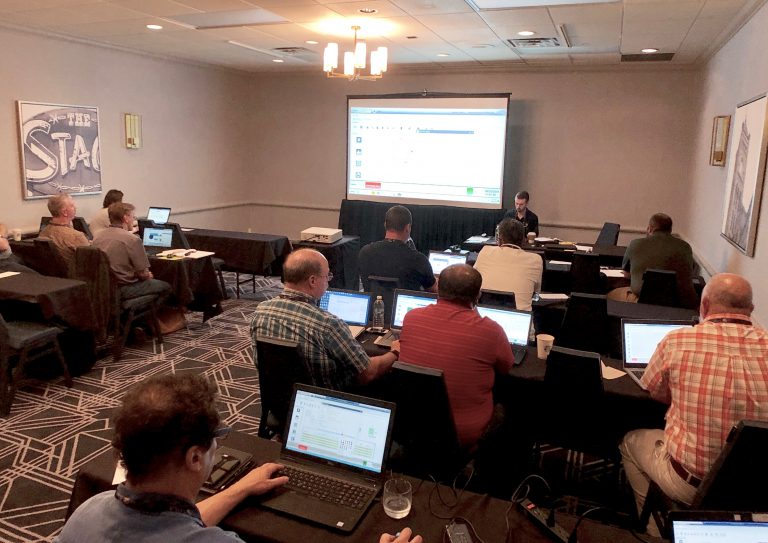Audit Services
Our team will review permits, procedures, reports, and interview on-site Plan personnel, providing a complete summary highlighting risk and identifying areas of improvement. We support you by ensuring your CEMS and DAHS information follows necessary compliance regulations.
The primary function of the audit program is to ensure that all necessary monitoring, reporting, and record retention requirements are being met by your current system. A thorough review will be done of your QA/QC Plan, CEMS reports, preventive maintenance logs, corrective maintenance activities, and incident tracking systems to ensure compliance with the applicable regulations and your facility’s air operating permit.
The COMPAS Audit program also evaluates the accuracy of data. In today’s world, where public interest groups and competitors all have access to your emissions data, you need to know it is both accurate and true. Special attention is paid to identifying methods for reducing liability and making improvements to allow company management to become more aggressive in their compliance strategy,
The key to the COMPAS – CEMS Audit program is early detection followed by corrective action prior to implementing a data submittal. COMPAS provides more efficient time management resulting in higher quality results without the pressure of having to find answers against a critical regulatory deadline.
EPAS (Environmental Project Assessment Service)
The installation of new DAHS is a unique and complex project that many plant personnel may not experience during their careers. Moreover, the level of effort required to manage a DAHS installation project is typically in addition to existing plant staff workloads which can be taxing. Experience shows that there is often a void at the outset of a typical DAHS project where the project requirements and specifications have not been clearly defined. In the absence of clearly defined technical specifications, both the buyer and seller are often stuck in an uncomfortable position.
EPAS (Environmental Project Assessment Service) saves you time and resources. As a premier DAHS supplier, VIM knows that the key to success in implementing a DAHS solution lies with having the correct and detailed information needed before we build your application. Having the necessary information documented, along with quick and complete clarification leads to minimal rework down the road and most importantly, the correct data, measurements, calculations, and reporting to meet your needs.
Monitoring Plan
Are you sure your monitoring plan is compliant with the latest rules?
We can help identify changes that need to be made in both your electronic Monitoring Plan and the requisite written plan.
The overall objective of this service is to provide an unparalleled level of environmental support to your facility by delivering a Monitoring Plan that is not only in compliance with the Part 75 regulations but also useful to plant staff and easy to maintain.
Our monitoring plan format is specially designed with readability in mind. Using proven approaches for combining graphics for navigation, an easy-to-read text layout, and a crisp writing style, the plan accommodates the required elements while at the same time providing a practical and valuable record of the CEMS installation and setup.
QA/QC Plans
VIM’s QA/QC Plan format produces a plan that works for you. We compile usable procedures that will become an integral part of a well-documented compliance program. Compliance with ongoing CEMS QA/QC requirements can be complex cutting across several different regulations. For example, a standard Part 75 affected coal-fired unit may also be equipped with a continuous opacity monitoring system (COMS), Part 60 carbon monoxide (CO) monitor, as well as CEMS (e.g., mercury (Hg) CEMS, Hg sorbent trap monitoring systems (STMS), or particulate matter (PM) CEMS) for compliance with the MATS Rule. VIM has the experience and expertise necessary to package these various regulatory requirements into a user-friendly, fully compliant QA/QC Plan.
The objective of this service is to assist you in achieving your compliance goals by producing for your CEMS that meets the requirements of all applicable CEMS regulations but goes far beyond those requirements in terms of providing your facility personnel a document that will be referenced on a daily basis and that will ensure that your vision for your CEMS is realized.
The VIM’s COMPAS philosophy for QA/QC Plans is that they are not merely repositories for information that the regulations require, but rather, that they are tools to help you reach full compliance. We accomplish this by providing the information your team needs in a task-oriented manner. Our QA/QC Plan format is specially designed with readability and usability in mind. We use graphics for quick navigation, an easy-to-read text layout, and a crisp writing style to produce a plan that accommodates the required elements while at the same time providing the information your team needs on both a day-to-day basis and a reference basis to keep your system in compliance.
VIM will also review and update existing QA/QC Plans. Experience shows that a review of a source’s QA/QC Plan is a key component of a regulatory audit. However, the original QA/QC Plan often remains stagnant without being updated to reflect permit revisions, new CEMS equipment, changes to plant operations or new regulatory requirements.
Site-Specific Monitoring Plans
For sources subject to Part 63 (e.g., Subpart LLL, Portland Cement MACT; Subpart UUUUU, Utility MATS Rule), VIM also develops comprehensive Site-Specific Monitoring Plans. For these sources, the Site-Specific Monitoring Plan is often required in addition to the QA/QC Plan required under Appendix F of Part 60.
Regulatory Training
Regulatory training is offered on a consistent basis at our headquarters in Baltimore as well as at our User Groups. The trainings can be performed on-site and tailored to your site’s specific needs.
VIM offers detailed Part 60 and Part 75 and MATS Rule Regulations Training. Classes provide an in-depth review of monitoring, certification and reporting requirements. Participants receive detailed information on the following:
- DAHS architecture overview
- Alarms and events
- System engineering
- Calibration & audits
- Data review and QA Report generation
- Selecting monitoring methodologies
- Understanding monitoring plans
- Certifying CEMS
- MATS Rule Overview
- Continuous opacity monitoring systems (COMS)
- Hg CEMS, Hg STMS and PM CEMS
- Data validation
- Recertification/diagnostic test requirements
- Understanding EDRs
- 10-Step procedure to QA data
Reporting
Using our data analysis tools, we can identify inconsistencies in your data before they are submitted to the Environmental Authority. We offer several levels of reporting services from data analysis to complete report generation and submittal.
The overall objective of this service is to provide an unparalleled level of environmental support to your facility in the tasks of generating both Federal Electronic Data Reports (EDR), State-level Excess Emissions Reports (EER) as well as Semi-Annual Compliance Reports. In addition to reporting via EPA’s Emission Collection and Monitoring Plan System (ECMPS) software, VIM’s COMPAS group is experienced in reporting via the Compliance and Emissions Data Reporting Interface (CEDRI), Electronic Reporting Tool (ERT), and Greenhouse Gas e-GGRT reporting software.
The primary function of this program is to evaluate the condition of your reportable air compliance data and the suitability of your monitoring plan and certification data against a data validation model prior to submittal. Using our data analysis tools, we can ascertain any inconsistencies in the data that may cause a problem in EDR and EER submittals.
Left undetected and uncorrected, these errors may result in a poor EDR score, improperly filed EERs, or worse yet, poor data accuracy (not to be confused with data availability). Data inaccuracy often results in tighter agency scrutiny of the facility in general and potential electronic and field level audits.
DAHS Tuneups
Was your DAHS originally programmed five or ten years ago? Have changes been made to your operating permit, emissions monitoring system or plant process? Are you having to use external spreadsheets to track plant data or generate components of your required federal and/or State reports? If you answered yes to one or more of these questions, then a DAHS tuneup may be beneficial to ensure ongoing compliance and to streamline the reporting process. For a DAHS tuneup project, our team conducts a detailed review of the operating permit(s) and Part 75 monitoring plan (if applicable). After our initial review, VIM will host a conference call with plant personnel to discuss any plant operational changes, reporting issues or data gaps within the existing plant reporting process. If warranted, VIM may also conduct a site visit to obtain additional information needed to upgrade the DAHS. Next, VIM will provide the customer with a report summarizing our findings and recommendations for enhancing the DAHS and associated recordkeeping and reporting process. Put VIM’s extensive DAHS software and regulatory expertise to work for you!





